| Want to send this page or a link to a friend? Click on mail at the top of this window. |
More Special Reports |
| Posted February 24, 2008 |
Cheap Cocaine Floods a Slum In Argentina, Devouring Lives |
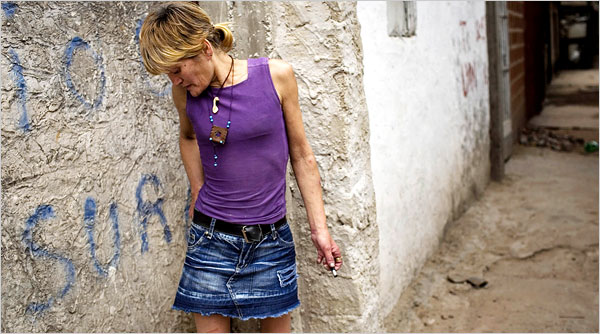 |
|
JOAO PINA FOR THE NEW YORK TIMES |
|
| A 45-year-old paco user with a cigarette made from the highly addictive cocaine residue in Ciudad Oculta, a Buenos Aires slum. |
By ALEXEI BARRIONUEVO |
BUENOS AIRES — Bilma Acuņa has two drug-addicted sons and roams the streets of the Ciudad Oculta slum here with a purpose: to save others from the same fate.
She and the group of mothers she helps organize have become the only bulwark, it seems, against the irrepressible spread of paco, a highly addictive, smokable cocaine residue that has destroyed thousands of lives in Argentina and caused a cycle of drug-induced street violence never seen before in this country.
The scourge underscores a significant shift in both Argentina and its larger neighbor, Brazil, which in just a few years have become sizable cocaine consumers. Brazil now ranks as the second largest consumer of cocaine in the world after the United States, the State Department says.
The surge in drug use has been fueled by porous borders, economic hardship and, more recently, the rolling back of restrictions on coca growing since President Evo Morales took office in 2006 in neighboring Bolivia. The result has been the democratization of cocaine in this part of South America, which has become the dumping ground for cheaper, lower-quality cocaine.
In the five years since residents first began noticing the crude yellowish crystals being smoked on the streets of Ciudad Oculta, a neighborhood of 15,000 people within Buenos Aires, paco has become the dominant drug that dealers are peddling.
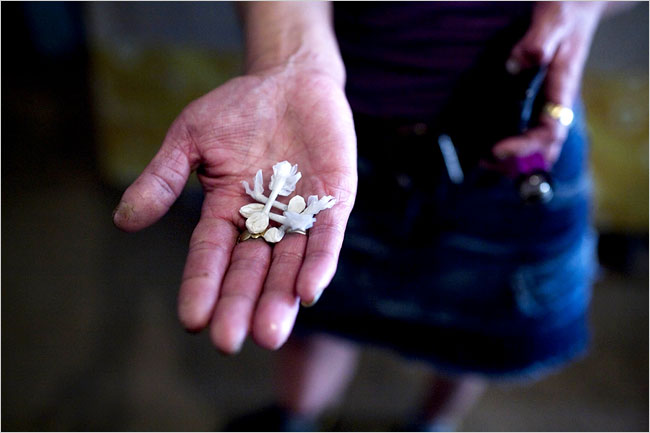 |
JOAO PINA FOR THE NEW YORK TIMES |
| An addict holding paco, a cocaine residue that is smoked. |
Just weeks after first trying the drug, Mrs. Acuņa’s son Pablo Eche began selling everything he owned to feed his addiction. He committed violent robberies. In a drug-fueled rage he destroyed his house and then sold the land that was left, ending up freezing and alone on the streets until his grandmother took him in.
“The majority of the kids are using here,” said Mrs. Acuņa, 46. “My son saw what was happening with the kids in the streets that were using paco, and he always said he wouldn’t get caught up in that. But he did.”
The challenges to stopping the flow are immense. Fewer than 200 federal police officers patrol Brazil’s 2,100-mile border with Bolivia, though the Brazilian government says reinforcements are on the way. Only 10 percent of Argentina’s airspace is covered by radar, leaving traffickers free rein.
Cocaine seizures and major drug raids in Argentina and Brazil have surged in the past two years. The influx of raw cocaine paste used to make crack, from both Bolivia and Peru, has been particularly acute. In Brazil, such seizures by the federal police nearly quadrupled from 2006 to 2007, to 2,700 pounds from about 710 pounds, according to the police.
In Argentina, the deep financial crisis of late 2001 turned places like Ciudad Oculta into what are known here as villas miserias, or towns of misery, easily exploitable markets of impoverished people looking for escape.
“Cocaine is no longer the drug only of the elite, of high society,” said Luiz Carlos Magno, a Brazilian narcotics officer in the São Paulo State Police Department.
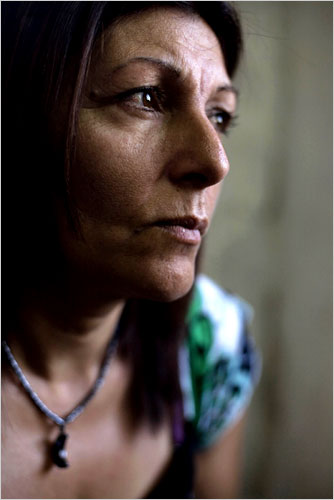 |
JOAO PINA FOR THE NEW YORK TIMES |
| Bilma Acuņa has two sons who are addicted to paco. |
“Today kids buy three lines of cocaine for 10 reals,” or about $6. For about $1 in Brazil and about $1.50 in Argentina, users can buy enough of the cocaine for a 15-minute high.
Paco is highly addictive because its high lasts just a few minutes — and is so intense that many users smoke 20 to 50 paco cigarettes a day to try to make its effects linger. Paco is even more toxic than crack cocaine because it is made mostly of solvents and chemicals like kerosene, with just a dab of cocaine, Argentine and Brazilian drug enforcement officials said. The surge in lower-quality cocaine hitting the streets has resulted from a crackdown by both countries on the chemicals needed to transform cocaine paste, or pasta base, as it is called, into powder form.
Tougher customs rules to track the flow of the chemicals, manufactured in large quantities in both countries, have limited access for Bolivian traffickers seeking to refine the base cocaine into higher-value powder, said Gen. Roberto Uchõa, Brazil’s national drug secretary.
As the quality of Bolivian cocaine has fallen off, the European market, in particular, has rejected it, the general said. So more of it has gone to Argentina and Brazil. In São Paulo, the police say the cocaine on the streets is less than 30 percent pure. “Every year they are producing more, and that is driving down prices,” said Mr. Magno, with the state police.
Traffickers are cutting the cocaine powder with everything from boric acid to lidocaine to baking powder, leading to severe health effects like infections and blood clots, health officials said. “It is the garbage cocaine that is coming here,” Mrs. Acuņa said. “The kids here are smoking garbage.”
Mrs. Acuņa, a soft-spoken Paraguayan native, is battling paco’s spread to save the barrio, but also to save her family. Tragedy first struck in August 2001 when two drug dealers shot and killed her 16-year-old son, David, one week after he was believed to have witnessed a murder. The dealers are now in prison for his death.
A few years later Pablo Eche, her eldest son, and her younger son, Leandro, 20, became addicted to paco. That was when she helped form a Mothers of Paco support group.
With less than three dozen members in Ciudad Oculta, the mothers have few ways to counter the armed dealers who hold sway over the neighborhood. Instead, they find safety in numbers.
On one recent afternoon, Mrs. Acuņa led a walk through the Oculta with some eight women. As she walked along the mostly unpaved streets, Bolivian and Paraguayan music blaring from open windows, she pointed out kiosks and red brick homes where dealers were known to sell. A teenager strode by at one point, a pistol stuffed in the front of his shorts.
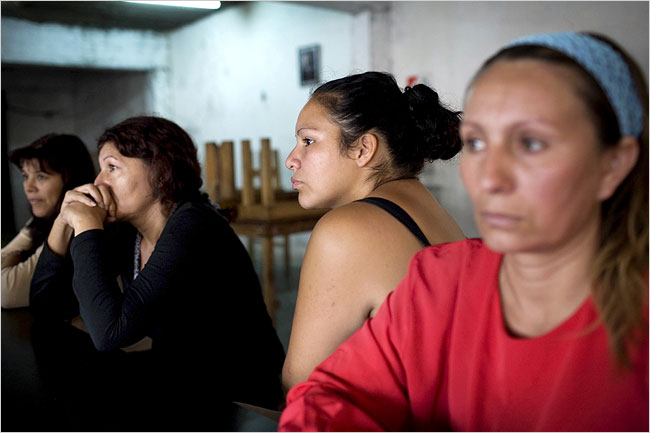 |
JOAO PINA FOR THE NEW YORK TIMES |
| A group of mothers of paco addicts meeting in Ciudad Oculta. They are trying to find ways to halt the spread of the drug. |
A tiny police station the size of a one-car garage sat in a makeshift plaza. A police car was parked outside. “The police haven’t entered here much since 2001,” Mrs. Acuņa explained.
Argentine government officials have increased money in recent years for drug education, prevention and rehabilitation, but they have yet to announce any major plans to tackle the paco problem, which has left local law enforcement officials overwhelmed.
Instead, led by the mothers, residents are largely taking matters into their own hands. Mrs. Acuņa fields dozens of calls a week from mothers seeking help with their children’s addictions. She refers some to government-run psychiatric clinics, and urges others, some of them recovering from addictions themselves, to join the group.
Mrs. Acuņa operates a small diner with a bare concrete floor where the mothers hold many of their meetings. At one meeting on Jan. 28, Liliana Barrionuevo blurted out that not enough was being done to crack down on the dealers. Some mothers cast their eyes around nervously, fearful of reprisals.
“Before there were codes,” another mother, Andrea Cordero, chimed in angrily. “The dealers would never sell to young kids, and the users would never use in public. Now there are no codes. We need to stand up and stick it to two or three dealers.”
The descent of Mrs. Acuņa’s son Pablo Eche parallels that of his neighborhood. His addiction began in 2003, when he was 21. His girlfriend at the time, six months pregnant with their son, left him and moved to Italy. Argentina’s economic crisis was still ravaging the country, and Ciudad Oculta was gripped by hopelessness.
Every day seemed to be worse. “The lack of money isn’t the nightmare,” Mr. Eche said of the economic crisis. “It’s the pressure that it causes in a person, the desperation and the depression.” He said he “was looking for a way to not feel anything, to not feel sadness, to find a way not to cry.”
For months he had passed the kiosk on a corner near his house where he knew dealers were selling a new drug, one, it was whispered, that could cheaply fill that hollow place inside. “I always passed it, but never bought anything,” he said.
Then one day he did.
From the first 15 minutes, paco seized his soul. Soon, he could no longer hold a job, even at his mother’s diner. And he could never have enough. At one point he went on a three-day paco bender without a wink of sleep, he said.
Three months after smoking his first pipe, he sold anything he could to turn into cash for paco. Finally, in a drug-induced hysteria, he destroyed the one-bedroom house his mother had given him, tearing down the roof and walls and ripping out the flooring. Eight months into his addiction, he sold what was left for about $315, one-quarter what his mother had paid.
His relationship with his mother was in shambles. He had stolen from her, and stolen from other family members as well. “I had turned into a nobody to her,” he said. “I caused her a lot of pain.”
He was homeless, starving and suffering from severe drug-induced chills when his grandmother finally took him in. His mother later came around.
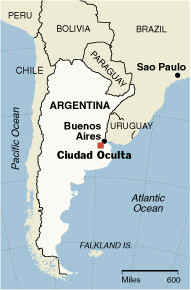 |
THE NEW YORK TIMES |
| Some 15,000 people live in the Ciudad Oculta slum. |
These days, his eyes are clear, his voice steady. Interned at a drug-dependency clinic some 40 minutes from Ciudad Oculta — his fourth rehabilitation stint — he said he had been clean of drugs since October.
Now 25, he is again writing poetry, something he had not done since before he discovered paco. “The future is uncertain,” he said. “But I am getting back my dreams.”
But he worries about his brother Leandro, who is still prone to all-night paco benders. “I hope he finds a way to stop,” he said. And he mourns for Ciudad Oculta. “Right now I can see all the little kids lining up to buy,” he said, closing his eyes deeply. “Paco is a plague. Somehow we need to protect them from this.”
Joao Pina contributed reporting.
Copyright 2008 The New York Times Company. Reprinted from The New York Times, International, of Saturday, February 23, 2008.
| Wehaitians.com, the scholarly journal of democracy and human rights |
| More from wehaitians.com |